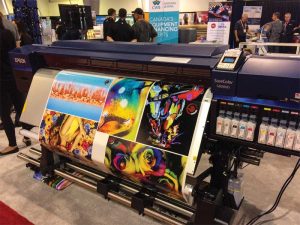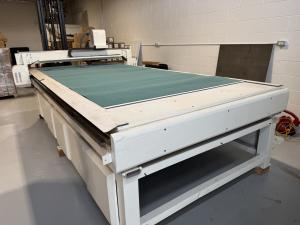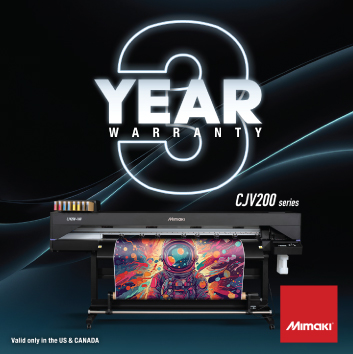Technologies and trends in the print market
Output widths
Most digital wide-format output is 1067 mm (42 in.) wide or less. This is true for flexible
as well as rigid media types. Wider widths are generally more popular among enterprises with higher annual revenues. The most common digital output widths among sign shops are 1372 mm (54 in.) and 1219 mm (48 in.).

Media expenditures
The roll media sign market has evolved from its earliest days of primarily aqueous substrates. Today, there are a number of other low-cost media types. Despite these improvements, print media remains a significant cost for wide-format print shops. Industry research shows sign shops spend an average of nearly $47,000 per year on digital wide-format printing media with more than half of printing businesses expecting an increase in ink and media expenditures. Although higher costs are often viewed as a negative, they are also a sign of an industry that is experiencing healthy growth.
Media types
Flexible media continues to represent the lion’s share of the market. With the growth of UV-curable inkjet printers, particularly flatbed inkjet printers, the use of rigid substrates for digital printing has increased tremendously. Typically starting at $50,000, flatbed UV-curable inkjet printers represent a significant investment, but offer productivity advantages compared to older processes that require mounting.
When it comes to choosing the right substrate for a project, it is often necessary to consider display placement requirements as well as durability. Self-adhesive vinyl is widely used because it can be mounted and applied to rigid media with or without lamination. Today, many rigid media jobs are often precoated on one or both sides for flexibility in ink sets.
Flexible media
Wide-format print shops use pressure-sensitive vinyl for a variety of applications. Sign shops that mount
this vinyl onto a flat panel would likely benefit from the acquisition of UV-curable/flatbed inkjet printers. These devices can often reduce the cost of labour and additional print media used in the mounting step. Other common applications include backlit signs, vehicle wraps/graphics, and window graphics.
Rigid media
These media boards are suitable for rigid wide-format printing applications, ranging from cardboard to aluminum composite. Plastic applications can be quite versatile and are available in sheets for signs, displays, and a variety of other uses. Other types of rigid board media are suitable for signs, displays, and decorative panels. Particle boards offer a number of different densities, while plywood can be finished with paint or vinyl to form a receptive coating. These materials are designed for décor and signage applications and can
also be used to build interior store structures.
Most UV printing equipment is capable of printing onto standard rigid materials including wood, metal, stone, and glass. At the same time; however, weight and handling characteristics may cause limitations for some of the more exotic substrates. Most substrates are developed specifically for wide-format printing. These include paper-based boards with a good strength-to-weight ratio that can be easily cut into shapes. Perhaps, the most basic of these is corrugated board, which uses fluted paper in between two sheets of linerboard. There are different grades determined by the mount of fluted material—the size of the flutes (i.e. the bumps inside the board) determines the thickness and characteristics of the media.
Many signmakers produce a mix of rigid substrates on their wide-format digital printers, the greatest share of the output being produced on foam core substrates. Some are also produced on corrugated plastic. Other popular substrates such as wood and metals are likely composite products. Today’s UV-curable printers are versatile enough to print onto a wide range of substrates, including acrylic and corrugated.



